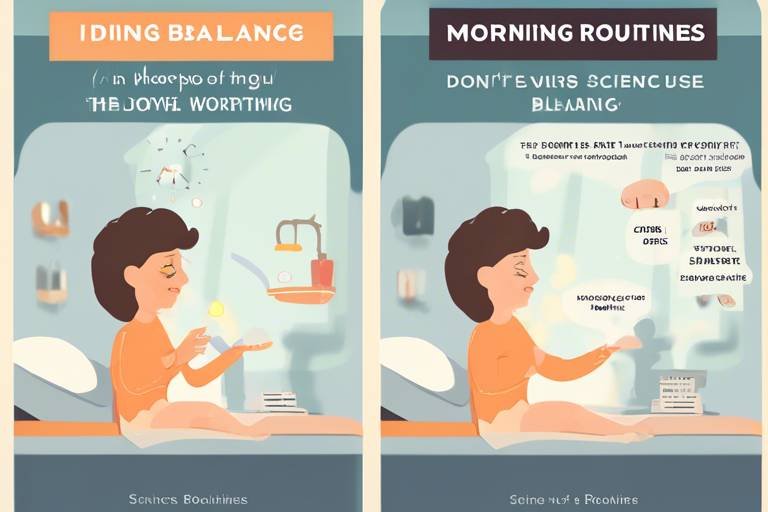How Light Exposure Affects Our Daily Lives
Have you ever noticed how a sunny day can instantly lift your mood? Or how a dimly lit room can make you feel sleepy and unproductive? Light exposure is not just about visibility; it plays a crucial role in our daily routines, impacting our health, mood, productivity, and overall well-being. In our fast-paced world, we often overlook the significance of light and how it influences our lives. This article delves into the profound effects of light exposure, unraveling the science behind it and providing practical tips to optimize our environments for better living.
Understanding the basic principles of light is essential to appreciate its role in our lives. Light, particularly natural sunlight, regulates our circadian rhythms, which are our internal biological clocks that dictate our sleep-wake cycles. When exposed to natural light, our bodies produce melatonin, a hormone that helps us sleep, and serotonin, which boosts our mood. The balance of these hormones is vital for our mental and physical health. Moreover, studies reveal that light exposure can enhance cognitive functions, aiding in concentration and memory retention. So, the next time you feel sluggish, consider whether you're getting enough light!
In today's world, we are surrounded by both natural and artificial light. But did you know that these two types of light affect us differently? Natural light, which comes from the sun, is rich in full-spectrum wavelengths, while artificial light often lacks this spectrum and can sometimes be harsh on our eyes. Incorporating natural light into our daily environments is crucial for maintaining optimal health and productivity. Research shows that individuals who work in environments with ample natural light report higher levels of satisfaction and lower levels of stress. But how do we harness the power of natural light?
Natural light is like a miracle worker for our bodies and minds. Here are some of the incredible benefits:
- Improved Mood: Exposure to sunlight increases serotonin levels, which can lead to a happier and more positive outlook on life.
- Increased Vitamin D Production: Sunlight is a natural source of vitamin D, essential for bone health and immune function.
- Enhanced Focus: Studies show that natural light can improve concentration and reduce eye strain, making it easier to stay productive.
Imagine sitting in a brightly lit room filled with sunlight streaming through the windows. You feel energized, focused, and ready to tackle your tasks. That's the power of natural light!
Research has shown that natural light exposure can alleviate symptoms of depression and anxiety. For many, the winter months can be particularly challenging due to the lack of sunlight. Seasonal Affective Disorder (SAD) is a condition where individuals experience depressive symptoms during specific seasons, often due to reduced sunlight. By increasing exposure to natural light, whether through outdoor activities or strategically placing mirrors to reflect light indoors, we can enhance our emotional well-being. It's like giving your brain a dose of happiness!
Natural light doesn’t just make us feel good; it also makes us work better. Studies have indicated that employees who work in environments with ample natural light are more productive and report higher job satisfaction. Imagine the difference it could make if offices were designed with large windows and open spaces that allow sunlight to flood in. The simple act of optimizing light exposure can lead to better performance and a more enjoyable workplace.
While artificial light is essential for modern living, it poses challenges that we must address. For instance, excessive exposure to artificial light, especially in the evening, can disrupt our sleep patterns. This interference can lead to insomnia and fatigue, affecting our overall health. Moreover, the blue light emitted from screens can contribute to eye strain and discomfort. Recognizing these challenges is the first step in creating a more balanced light environment that promotes well-being.
Sleep quality is heavily influenced by light exposure. The body’s natural circadian rhythms are closely tied to the light-dark cycle. When we expose ourselves to bright lights in the evening, we trick our bodies into thinking it’s still daytime, which can delay sleep onset. To foster better sleep, it’s essential to create a sleep-friendly environment that minimizes light exposure during the night.
Blue light, emitted from our phones, tablets, and computers, can interfere with our sleep and circadian rhythms. This type of light suppresses melatonin production, making it harder to fall asleep. To mitigate its impact, consider using blue light filters on your devices or wearing blue light-blocking glasses in the evening. It's like putting on a pair of sunglasses for your eyes, allowing you to enjoy your screen time without sacrificing your sleep!
Designing a bedroom that minimizes light exposure can significantly enhance sleep quality. Here are some tips to create a restful sanctuary:
- Use blackout curtains to block out external light.
- Consider dimmable lights for a softer glow in the evening.
- Avoid screens at least an hour before bedtime.
By optimizing your sleep environment, you can promote restful nights and rejuvenating mornings, setting the stage for a productive day ahead.
1. How much natural light do I need daily?
Most experts recommend at least 30 minutes of natural light exposure each day to reap the benefits for your mood and health.
2. Can artificial light affect my sleep?
Yes, excessive exposure to artificial light, especially blue light from screens, can disrupt your circadian rhythms and negatively impact sleep quality.
3. What are some easy ways to increase natural light in my home?
You can increase natural light by keeping curtains open during the day, using mirrors to reflect light, and choosing lighter colors for walls and furniture.

The Science of Light and Its Effects
Light is more than just a source of illumination; it fundamentally shapes our daily lives in profound ways. At the core of this influence is the concept of circadian rhythms, which are the natural processes that regulate our sleep-wake cycles and other bodily functions over a 24-hour period. These rhythms are heavily influenced by light exposure, particularly the blue wavelengths emitted by the sun during the day. When we expose ourselves to natural light, our bodies produce melatonin in response to the darkness, signaling to us that it’s time to wind down and prepare for sleep. Conversely, exposure to bright light during the day helps us feel more awake and alert.
Moreover, light plays a crucial role in our mood and cognitive functions. Studies have shown that people who spend more time in natural light tend to report higher levels of happiness and satisfaction. This is partly due to the increased production of serotonin, a neurotransmitter that contributes to feelings of well-being and happiness. In fact, the relationship between light and mood is so significant that some mental health professionals recommend light therapy as a treatment for conditions like Seasonal Affective Disorder (SAD).
But what exactly happens in our bodies when we are exposed to light? It all boils down to photoreceptors in our eyes, specifically a type called intrinsically photosensitive retinal ganglion cells (ipRGCs). These cells are sensitive to light and play a key role in regulating our circadian rhythms. When light hits these cells, it sends signals to the brain, which then influences our sleep patterns, hormone release, and even our mood. This intricate relationship highlights the importance of understanding how light affects us on a biological level.
To further illustrate the effects of light on our health, consider the following table that summarizes the various impacts of light exposure:
| Type of Light | Effects on Health | Recommended Exposure |
|---|---|---|
| Natural Light |
|
At least 30 minutes daily |
| Artificial Light |
|
Limit exposure before bedtime |
In summary, the science of light reveals that our exposure to various types of light has a significant impact on our health, mood, and productivity. By understanding these effects, we can make informed decisions about how to optimize our environments for better well-being. Whether it’s seeking out natural light during the day or minimizing artificial light exposure at night, small changes can lead to profound benefits in our daily lives.

Natural Light vs. Artificial Light
When we think about light, it’s easy to take it for granted, but the truth is, natural light and artificial light play vastly different roles in our lives. Natural light, which comes from the sun, is a vital source of energy that not only illuminates our surroundings but also influences our health, mood, and overall well-being. On the other hand, artificial light, produced by various man-made sources like bulbs and screens, has become an integral part of our modern existence. But how do these two types of light stack up against each other?
First, let’s consider the source. Natural light varies throughout the day and is influenced by weather conditions, while artificial light is constant and can be adjusted to our preference. This variability in natural light helps regulate our circadian rhythms—the internal clock that tells us when to sleep and when to wake up. In contrast, artificial light can disrupt these rhythms, particularly when we use it late at night. Have you ever noticed how you feel more awake when you’re exposed to sunlight? That’s no coincidence! Natural light boosts the production of serotonin, a hormone that enhances mood and focus.
Moreover, the spectrum of light is different between natural and artificial sources. Natural light includes a full spectrum of wavelengths, which is crucial for our physical and mental health. It provides us with essential vitamin D, which is vital for bone health and immune function. Artificial light, especially fluorescent and LED lighting, often lacks this full spectrum and can lead to deficiencies in vitamin D levels, especially during the winter months when sunlight is scarce.
| Aspect | Natural Light | Artificial Light |
|---|---|---|
| Source | Sun | Bulbs, LEDs, Screens |
| Spectrum | Full spectrum | Often limited spectrum |
| Health Benefits | Boosts mood, Vitamin D production | Can disrupt sleep and cause eye strain |
| Regulates Circadian Rhythms | Yes | Can disrupt |
In terms of productivity, workplaces that harness natural light have been shown to enhance employee performance and satisfaction. Studies reveal that employees who work in environments with ample sunlight report feeling more energetic and focused. This is because natural light helps reduce fatigue and increases alertness. On the flip side, excessive exposure to artificial light, especially in the form of screens, can lead to eye strain and headaches, making it crucial to find a balance.
So, what does this mean for us? It’s essential to prioritize natural light in our daily routines. Whether it’s choosing an office with large windows, taking breaks outside, or simply rearranging your home to let in more sunlight, the benefits are undeniable. Embracing natural light not only enhances our physical health but also uplifts our mood and sharpens our mental clarity.
In conclusion, while artificial light has its place in our lives, it’s the natural light that truly nourishes our bodies and minds. By understanding the differences and making conscious choices about our light exposure, we can significantly enhance our well-being and productivity.
- How does natural light affect mood? Natural light increases serotonin levels, which can help improve mood and reduce feelings of depression.
- Can artificial light disrupt sleep? Yes, particularly blue light emitted from screens can interfere with your sleep cycle by suppressing melatonin production.
- What are some ways to increase natural light in my home? Consider using lighter colors for walls, mirrors to reflect light, and keeping windows unobstructed.

Benefits of Natural Light
Natural light is like a breath of fresh air for our bodies and minds. It's not just about being able to see better; it has profound effects on our overall well-being. Imagine waking up in the morning, the sun peeking through your window, casting warm rays across your room. This simple moment can set the tone for your entire day. Studies show that exposure to natural light can significantly improve our mood, boost productivity, and even enhance our health. But how does this work? Let's dive deeper into the myriad benefits of natural light.
First and foremost, natural light is a potent mood enhancer. When sunlight enters our eyes, it stimulates the production of serotonin, a neurotransmitter that contributes to feelings of happiness and well-being. This is why you might feel a little more cheerful on sunny days compared to gloomy ones. In fact, many people experience a dip in mood during the winter months when daylight is scarce, a condition known as Seasonal Affective Disorder (SAD). By maximizing our exposure to natural light, we can help combat these feelings of sadness and lethargy.
Moreover, natural light plays a crucial role in the production of vitamin D. This essential vitamin is primarily obtained through sunlight exposure, and it’s vital for various bodily functions, including maintaining strong bones and a healthy immune system. When you soak in those sunny rays, your body converts cholesterol into vitamin D, which is crucial for calcium absorption. This is particularly important for those who may not get enough vitamin D through diet alone.
Another significant benefit is how natural light can enhance focus and cognitive function. Research indicates that workplaces flooded with natural light lead to better concentration and higher productivity levels. Employees in environments with ample sunlight report feeling more energized and engaged in their tasks. It’s no wonder that many companies are investing in designs that maximize natural light in their office spaces. In fact, a study found that employees working in naturally lit offices had a 15% increase in productivity compared to those in artificially lit settings.
To summarize, the benefits of natural light are extensive:
- Mood Improvement: Enhances feelings of happiness and reduces symptoms of depression.
- Vitamin D Production: Essential for bone health and immune function.
- Increased Productivity: Leads to better focus and engagement in work environments.
Incorporating more natural light into our lives doesn’t have to be complicated. Simple changes, such as rearranging furniture to allow more sunlight into your workspace or taking breaks outside during the day, can make a huge difference. So, the next time you find yourself feeling a bit down or unproductive, consider whether you’re getting enough of that glorious natural light!

Impact on Mental Health
When we think about our mental health, we often focus on therapy, medication, or lifestyle changes. But have you ever considered the role of natural light in this equation? It’s fascinating how something as simple as sunlight can have profound effects on our mood and emotional well-being. Studies have shown that exposure to natural light can significantly alleviate symptoms of depression and anxiety. Imagine waking up in the morning, drawing back the curtains, and letting the sun flood your room. It’s like a natural reset button for your mind!
So, how does this work? Well, when our skin absorbs sunlight, it triggers the production of serotonin, a neurotransmitter that helps regulate mood. Higher serotonin levels can lead to feelings of happiness and calmness, making us feel more energized and focused throughout the day. In contrast, a lack of sunlight can lead to lower serotonin levels, which is often associated with feelings of sadness or lethargy. It's almost like the sun is a natural mood booster, and who wouldn’t want that?
Additionally, natural light exposure helps regulate our circadian rhythms, which are our body’s internal clocks. These rhythms influence not just our sleep patterns but also our overall mental health. When our circadian rhythms are disrupted, it can lead to a range of issues, including mood disorders. It's like trying to tune a radio to your favorite station; without the right frequency, all you get is static. By ensuring we get enough natural light during the day, we can help keep our internal clocks in sync and our moods more stable.
However, it’s not just about soaking up the sun; it’s also about how we incorporate light into our environments. Here are some practical tips to enhance your mental health through light exposure:
- Spend time outdoors during the day, especially in the morning.
- Keep your curtains open to let in as much natural light as possible.
- Consider using light therapy lamps during the winter months or in areas with limited sunlight.
- Engage in activities that bring you closer to natural light, such as gardening or walking in a park.
Incorporating these practices into your daily routine can be a game-changer for your mental health. It’s a simple yet effective way to harness the power of light to boost your mood and overall well-being. So the next time you feel a little down, remember to step outside and bask in the sunlight; it might just be the pick-me-up you need!
Q: How long should I spend in natural light for mental health benefits?
A: Aim for at least 15-30 minutes of direct sunlight exposure each day, especially in the morning.
Q: Can artificial light have the same effects as natural light?
A: While artificial light can help, it generally doesn't provide the same benefits as natural sunlight, particularly in terms of vitamin D production and mood enhancement.
Q: What are some signs that I might be lacking natural light?
A: Symptoms can include feelings of sadness, lethargy, disrupted sleep patterns, and difficulty concentrating.

Enhancing Productivity
When it comes to productivity, the environment we work in plays a crucial role, and one of the most significant factors is light exposure. Imagine trying to focus on a task in a dimly lit room; it feels like trying to drive a car with fogged-up windows—frustrating and ineffective. Natural light, on the other hand, acts like a turbocharger for our brains, boosting our energy levels and enhancing our ability to concentrate. Studies have shown that workplaces flooded with natural light can significantly increase employee productivity, creativity, and overall job satisfaction.
But what exactly is happening when we bask in the glow of the sun? Well, natural light helps regulate our circadian rhythms, the internal clock that dictates our sleep-wake cycles. When we are exposed to bright, natural light during the day, our bodies produce serotonin, a neurotransmitter that not only elevates mood but also enhances focus and cognitive function. In contrast, working in artificial light can lead to feelings of lethargy and disengagement, making it harder to stay productive. It’s like trying to run a marathon with a backpack full of bricks—exhausting and counterproductive!
Moreover, incorporating natural light into your workspace doesn’t just improve productivity; it can also foster a sense of well-being and satisfaction among employees. Organizations that prioritize natural light often see lower absenteeism rates and higher morale. A study conducted by the Herman Miller Research Corporation found that employees who worked in environments with ample daylight reported a 15% increase in productivity compared to those in windowless offices. It’s no wonder that many modern office designs now include large windows and open spaces that allow sunlight to pour in.
To truly harness the power of natural light, consider these practical tips:
- Position Your Desk Wisely: If possible, place your desk near a window. This allows you to take advantage of natural light throughout the day.
- Use Light Colors: Light-colored walls and furniture can reflect natural light, making the space feel brighter and more inviting.
- Take Breaks Outside: Don’t underestimate the power of stepping outside for a few minutes. Fresh air and sunlight can rejuvenate your mind.
In conclusion, the relationship between light exposure and productivity is undeniable. By optimizing your environment to include more natural light, you can enhance your focus and efficiency, leading to better performance in both personal and professional settings. So, the next time you feel your productivity waning, consider whether your workspace is adequately illuminated by the sun. Embrace the light, and watch your productivity soar!
Q: How much natural light do I need for optimal productivity?
A: Ideally, you should aim for at least 30 minutes of natural light exposure during your workday. This can be achieved by positioning your workspace near a window or taking breaks outside.
Q: Can artificial light be beneficial for productivity?
A: While natural light is preferable, certain types of artificial lighting, like full-spectrum bulbs, can mimic natural light and help improve focus and mood.
Q: What are some signs that I need more natural light in my workspace?
A: If you frequently feel tired, unfocused, or experience eye strain, it may be a sign that your workspace lacks adequate natural light.

Challenges of Artificial Light
In our fast-paced, modern world, artificial light has become a staple of our daily lives. While it offers convenience and allows us to extend our activities well into the night, it also brings along a host of challenges that can negatively impact our health and well-being. One of the most significant issues is the disruption of our natural sleep patterns. Have you ever found yourself tossing and turning at night, staring at the ceiling, wondering why you can’t drift off? The culprit might just be the bright lights from your devices or overhead fixtures.
Artificial light, especially the kind that emits blue wavelengths, can trick our brains into thinking it’s still daytime. This interference with our circadian rhythms can lead to a cascade of problems, including insomnia, fatigue, and decreased productivity during the day. According to research, exposure to artificial light after sunset can delay the release of melatonin, the hormone responsible for regulating sleep. As a result, we end up feeling more tired and less focused, which can affect our performance at work or school.
Moreover, excessive exposure to artificial light can lead to eye strain, a condition that has become increasingly common in our screen-dominated lives. Symptoms of eye strain include headaches, blurred vision, and dry eyes, which can leave us feeling uncomfortable and distracted. This issue is particularly prevalent among individuals who spend long hours in front of computers or smartphones. The blue light emitted by these devices can contribute to digital eye strain, causing discomfort and fatigue that can linger long after we’ve put our devices down.
In addition to physical discomfort, the emotional toll of artificial light cannot be overlooked. Studies have shown that environments dominated by harsh, artificial lighting can lead to feelings of anxiety and stress. The stark contrast between the soft, warm glow of natural light and the harshness of fluorescent bulbs can create an unwelcoming atmosphere that affects our mood. A well-lit space should inspire creativity and comfort, not anxiety and unease.
To illustrate the challenges posed by artificial light, consider the following table that outlines the key differences between natural and artificial light:
| Aspect | Natural Light | Artificial Light |
|---|---|---|
| Source | Sunlight | Bulbs, LEDs, screens |
| Color Temperature | Varies throughout the day | Often harsh and static |
| Health Effects | Boosts mood, improves sleep | Can disrupt sleep, cause eye strain |
| Productivity | Enhances focus and creativity | Can lead to fatigue and distraction |
In summary, while artificial light is a necessary part of our lives, it’s crucial to recognize its challenges. From disrupting our sleep to causing eye strain and impacting our mood, the effects of artificial lighting can be detrimental. The key lies in finding a balance. By being mindful of our light exposure, especially in the evening, we can mitigate these negative effects and create a healthier, more productive environment.
- How can I reduce blue light exposure at night? Consider using blue light filters on your devices or wearing blue light-blocking glasses in the evening.
- What are some natural light sources I can incorporate into my home? Try to maximize window space, use light-colored curtains, or even consider skylights for an influx of natural light.
- Can artificial light affect my mood? Yes, harsh artificial lighting can lead to feelings of anxiety and stress, whereas softer, warmer lights can promote relaxation.

Light and Sleep Quality
When it comes to achieving a good night’s sleep, light exposure plays a pivotal role that many of us often overlook. Our bodies are finely tuned to respond to light, which is a key factor in regulating our circadian rhythms. These internal biological clocks dictate when we feel awake and when we feel sleepy, and light is the primary cue that influences this cycle. Think of it as nature’s alarm clock; when the sun rises, our bodies know it’s time to wake up, and when the sun sets, it’s time to wind down. However, with the prevalence of artificial light in our modern lives, especially from screens and devices, this natural rhythm can easily get disrupted.
Exposure to bright light during the day is essential for maintaining a healthy sleep-wake cycle. Natural light helps to boost serotonin levels, which can enhance your mood and help you feel more alert during the day. Conversely, when the day fades and darkness sets in, our bodies begin to produce melatonin, the hormone responsible for making us feel sleepy. So, how does this relate to sleep quality? Well, if you're exposed to too much artificial light in the evening, particularly blue light from screens, it can trick your brain into thinking it's still daytime. This can lead to difficulties in falling asleep and can significantly reduce the quality of your sleep.
To illustrate the impact of light on sleep, consider the following table that summarizes the effects of different light sources on our sleep quality:
| Light Source | Effect on Sleep |
|---|---|
| Natural Light | Enhances mood, regulates circadian rhythms, promotes melatonin production at night. |
| Artificial Light (especially blue light) | Disrupts melatonin production, makes it harder to fall asleep, reduces sleep quality. |
| Dim, Warm Light | Can promote relaxation and prepare the body for sleep. |
Now, you might be wondering, what can I do to improve my sleep quality in relation to light exposure? Here are some practical strategies to consider:
- Limit screen time at least an hour before bedtime. This includes phones, tablets, and computers that emit blue light.
- Use dim lighting in the evening. Opt for warm-toned lights to create a calming atmosphere.
- Invest in blackout curtains to minimize light pollution from outside, ensuring your bedroom is as dark as possible.
- Consider using blue light filters on your devices if you must use them at night.
By making these adjustments, you can create a sleep-friendly environment that fosters better sleep quality. Remember, the goal is to signal to your body that it’s time to relax and prepare for sleep. The less disruption you have from artificial light, the more likely you are to enjoy those restful nights and wake up feeling rejuvenated.
Q: How does light exposure during the day affect my sleep at night?
A: Exposure to natural light during the day helps regulate your circadian rhythms, making it easier to fall asleep at night.
Q: What are the best types of light for my bedroom?
A: Dim, warm-toned lights are ideal for creating a relaxing atmosphere conducive to sleep.
Q: Can using a blue light filter really help?
A: Yes! Blue light filters can reduce the amount of blue light emitted from screens, helping to minimize its disruptive effects on melatonin production.
Q: How long before bed should I stop using screens?
A: It's recommended to stop using screens at least an hour before bedtime to allow your body to wind down naturally.

Blue Light and Its Impact
In our hyper-connected world, blue light has become a buzzword that many of us encounter daily, yet few truly understand its implications. Blue light is a part of the visible light spectrum, which is emitted by various sources, including the sun, LED lights, and, most notably, our beloved electronic devices like smartphones, tablets, and computers. While blue light plays a crucial role in regulating our circadian rhythms and boosting alertness during the day, excessive exposure, especially during the evening, can wreak havoc on our sleep and overall health.
Research indicates that exposure to blue light in the evening can suppress the production of melatonin, the hormone responsible for regulating sleep. When melatonin levels drop, our bodies may struggle to wind down, leading to difficulties in falling asleep and maintaining a restful slumber. This disruption can create a cycle of sleep deprivation, which in turn can affect our mood, cognitive abilities, and even our immune system. In fact, studies have shown that individuals who frequently use screens before bedtime report lower sleep quality and increased feelings of fatigue the following day.
To illustrate the impact of blue light on our health, consider the following table:
| Effects of Blue Light Exposure | Short-term Effects | Long-term Effects |
|---|---|---|
| Sleep Disruption | Difficulty falling asleep, reduced sleep quality | Chronic insomnia, increased risk of sleep disorders |
| Mood Changes | Irritability, increased stress | Higher risk of anxiety and depression |
| Cognitive Performance | Reduced focus and attention | Long-term memory issues, decreased productivity |
| Eye Strain | Discomfort, dryness, blurred vision | Potential long-term vision problems |
So, what can we do to mitigate the adverse effects of blue light? Here are a few practical strategies:
- Limit Screen Time: Try to reduce your use of electronic devices at least one hour before bedtime.
- Use Blue Light Filters: Many devices now come with built-in blue light filters or "night mode" settings. Enable these features to reduce blue light emission in the evening.
- Wear Blue Light Glasses: Consider investing in a pair of blue light-blocking glasses, especially if you spend long hours in front of screens.
- Increase Natural Light Exposure: During the day, try to spend more time outdoors. Natural light can help regulate your body's circadian rhythm and improve your mood.
By implementing these simple changes, we can enjoy the benefits of technology while protecting our sleep and overall health. Understanding the impact of blue light is crucial in today’s digital age, where our screens often dictate our daily routines. Remember, a well-rested mind is not just more productive; it's also happier and healthier!

Creating a Healthy Sleep Environment
Creating a healthy sleep environment is essential for ensuring that you get the restful nights you deserve. Think of your bedroom as a sanctuary—a place where you can escape the chaos of the day and recharge your batteries. The right atmosphere can significantly enhance your sleep quality, making it easier to drift off and wake up feeling rejuvenated. So, how can you transform your space into a sleep haven? Let’s dive into some practical strategies!
First and foremost, consider the lighting in your bedroom. It’s crucial to minimize exposure to bright lights, especially blue light, in the hours leading up to bedtime. Blue light, emitted by screens and artificial lighting, can trick your brain into thinking it’s still daytime, thus hindering the production of melatonin—the hormone responsible for regulating sleep. To create a cozy ambiance, try using dim, warm lighting in the evening. You might even want to invest in smart bulbs that can adjust their color temperature based on the time of day.
Next, let’s talk about window treatments. Heavy curtains or blackout shades can make a world of difference by blocking out any unwanted light from street lamps or early morning sun. This way, you can ensure that your bedroom remains as dark as possible, allowing your body to produce melatonin naturally. If you’re a fan of fresh air, consider using sheer curtains during the day to let in natural light while still keeping your space private. It’s all about finding the right balance!
Another aspect to consider is the temperature of your sleeping environment. Studies have shown that the ideal sleeping temperature for most people is between 60 and 67 degrees Fahrenheit (15 to 19 degrees Celsius). A cool room can help lower your body temperature, signaling to your body that it’s time to sleep. If you find yourself feeling too hot at night, consider using breathable bedding materials like cotton or linen, which can help wick away moisture and keep you comfortable.
Additionally, the arrangement of your furniture can impact your sleep quality. Aim for a clutter-free space that promotes relaxation. A messy room can lead to a cluttered mind, making it harder to unwind. Try to keep your sleeping area tidy, and if possible, position your bed away from distractions such as electronics or work-related items. This simple change can help create a more peaceful atmosphere conducive to sleep.
Lastly, don't forget about the power of aromatherapy! Certain scents, such as lavender or chamomile, are known for their calming properties. You can use essential oil diffusers, scented candles, or even pillow sprays to infuse your space with these soothing aromas. Just a whiff of lavender can be enough to signal your brain that it’s time to wind down and prepare for a good night’s sleep.
In conclusion, crafting a healthy sleep environment involves a combination of proper lighting, temperature control, decluttering, and even scent. By making these adjustments, you can create a personal oasis that promotes deep, restorative sleep. Remember, your bedroom should be a place of relaxation and tranquility, where you can escape the stresses of the day and recharge for tomorrow!
- What is the best temperature for sleeping? The ideal sleeping temperature is typically between 60 and 67 degrees Fahrenheit (15 to 19 degrees Celsius).
- How can I block out light in my bedroom? Consider using blackout curtains or heavy drapes to minimize outside light exposure.
- What scents are best for promoting sleep? Lavender and chamomile are popular choices known for their calming effects.
- How does blue light affect sleep? Blue light can interfere with melatonin production, making it harder to fall asleep.
Frequently Asked Questions
- How does light exposure affect our mood?
Light exposure, especially natural sunlight, plays a crucial role in regulating our mood. It stimulates the production of serotonin, a hormone that contributes to feelings of happiness and well-being. When we don’t get enough natural light, especially during winter months, it can lead to seasonal affective disorder (SAD), which shows just how powerful light can be in influencing our emotions.
- What are the benefits of natural light in the workplace?
Natural light in the workplace can significantly boost productivity and job satisfaction. Studies have shown that employees who work in environments with ample natural light report higher energy levels and focus. Additionally, exposure to natural light can help reduce eye strain and headaches often caused by artificial lighting, leading to a healthier work environment.
- How can I optimize my home for better light exposure?
To optimize your home for better light exposure, consider incorporating more windows or using lighter curtains that allow sunlight to filter in. You can also strategically place mirrors to reflect light around your space. Additionally, try to declutter areas where light is meant to shine, ensuring that you make the most of the natural light available to you.
- What is blue light, and why is it a concern?
Blue light is a type of high-energy visible light emitted by screens such as computers, smartphones, and televisions. While it can enhance alertness and cognitive function during the day, excessive exposure, particularly in the evening, can disrupt our circadian rhythms and make it harder to fall asleep. This is why limiting screen time before bed is often recommended.
- How does light exposure affect sleep quality?
Light exposure directly influences our sleep quality by regulating our internal body clock, or circadian rhythm. Exposure to bright light during the day helps to reinforce a healthy sleep-wake cycle. Conversely, exposure to artificial light at night can confuse our bodies, making it difficult to fall asleep and stay asleep. Creating a dark, quiet environment at night is key to improving sleep quality.
- What are some tips for creating a sleep-friendly environment?
To create a sleep-friendly environment, consider using blackout curtains to block out any external light sources. Additionally, keep electronic devices out of the bedroom to minimize blue light exposure. You might also want to invest in a comfortable mattress and pillows, and maintain a cool room temperature to enhance your sleep experience.



















